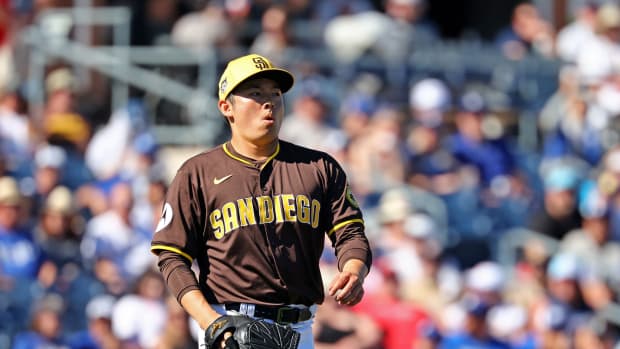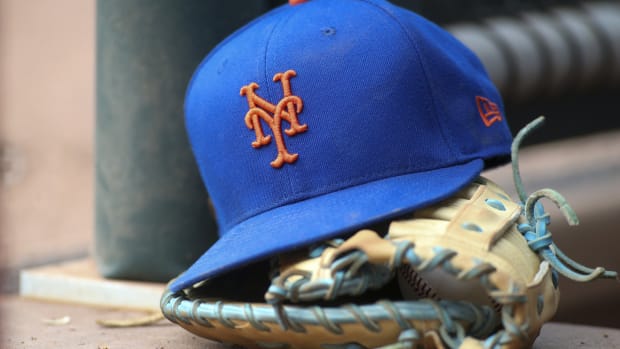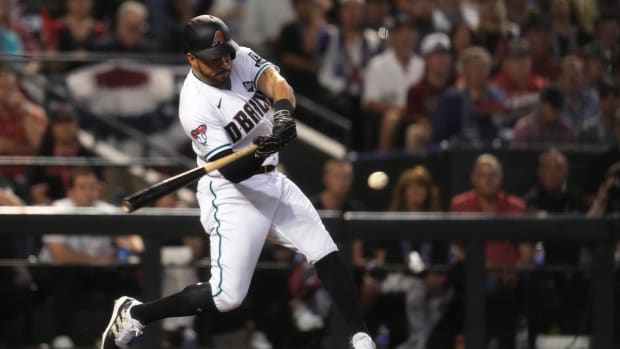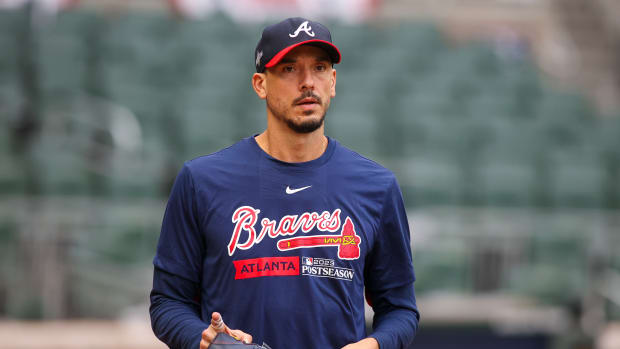Trade to Reds Might Be Worst-Case Scenario for Matt Harvey
The Matt Harvey saga is officially over in New York, but it's just beginning in a new and unlikely place. On Tuesday evening, the Mets announced they were trading Harvey, who was designated for assignment last Friday, to the Reds in exchange for catcher Devin Mesoraco. The deal is essentially a swap of broken-down former All-Stars, though for Harvey, the move to Ohio can charitably be described as a worst-case scenario.
It’s surprising that the Mets were able to get anything at all from Harvey, who hasn’t looked like a functional starting pitcher since the 2015 World Series. Saddled with a 7.00 ERA in 27 innings this season split between the rotation and bullpen, a fastball that struggles to crack 92 mph, and roughly $5 million owed to him this season, the righthander nonetheless drew trade interest from a number of teams. The Giants, Padres, Rangers, Orioles, Mariners and White Sox—pitching-needy, all—were reportedly in on Harvey, but it’s the basement-dwelling Reds who got him.
Matt Harvey's Quick and Agonizing Decline With the Mets Is No Mystery
To do so, Cincinnati gave up on Mesoraco, who once looked like part of the next great Reds team but has been a shell of himself for the last few seasons. The 29-year-old backstop and former first-round pick broke out in 2014 with a .273/.359/.534 line, 25 homers, a 147 OPS+ and 4.7 WAR in 440 plate appearances to earn a four-year, $28 million extension the following winter. But the deal proved to be a catastrophic mistake on Cincinnati’s part, as injuries have limited him to just 113 games over the last three-plus seasons. When Mesoraco has been able to get on the field, the results have been a far cry from that All-Star campaign in ’14: Since then, he’s hit .195/.291/.318 with a 63 OPS+.
Mesoraco is probably irreparably broken, but that won’t matter too much to the Mets, who just need a warm body at catcher. Opening Day starter Travis d’Arnaud was lost for the season in mid-April due to Tommy John surgery, and backup Kevin Plawecki was sidelined at almost exactly the same time with a broken hand. In their stead, New York has played light-hitting veteran Jose Lobaton and rookie Tomas Nido, but the two have predictably done nothing: The former has hit .163/.265/.256 in 49 plate appearances, and the latter has somehow been even worse at .147/.194/.176 in 36 PA. Mesoraco has barely topped that at .220/.289/.341 this season, but he does have some power and upside if he can stay healthy.
While the Mets get something potentially useful in Mesoraco, Harvey goes from a potential contender to a bottom-feeder in the Reds. There are few teams bleaker than Cincinnati, which has the worst record in baseball at 8–27. That’s by design, apparently: The Reds are amid year five of an endless and mismanaged rebuild, with no hope of contention in the near future. That makes the addition of Harvey somewhat odd. If he somehow recaptures his pre-thoracic outlet syndrome form, it won’t make any difference for a team that’s going to (and, arguably, trying to) lose 95-plus games. Plus, even if Harvey can turn back time, it won’t do the Reds any good in the future, either, as he’s a free agent at season’s end and unlikely to re-up with a rebuilding squad.
Why the Piping Hot Mookie Betts Is One of Baseball's Very Best Players
Then again, the Reds’ pitching staff is so awful that taking a chance on Harvey is probably worth it. Cincinnati doesn’t have a single starter with an ERA under 4.00 or an ERA+ over 100, and the rotation’s 5.58 ERA is second-worst in baseball, ahead of only the also-rebuilding White Sox. Plus, if Harvey does manage to find the fountain of youth in the Queen City (a fountain that definitely sprays Skyline Chili), the Reds could always flip him at the trade deadline for a prospect or two.
But that requires Harvey either gaining velocity on his fastball or figuring out how to pitch without it, and nothing from the last two seasons suggests he can do either right now. Nor is there anything in the Reds’ recent past to indicate that anyone on that team has any idea how to fix a pitcher when things go wrong. And in terms of landing spots, Cincinnati’s Great American Ball Park is just about the worst imaginable for a pitcher with subpar velocity and command issues. It is one of the most offense- and homer-friendly in baseball. For a pitcher trying to rebuild his value ahead of free agency, it’s a nightmare outcome.
Harvey will get his rotation spot back, but it comes at quite the price: perhaps the rest of the season spent with a last-place team in one of toughest parks in the majors to pitch in, laboring through Cincinnati’s heavy summer heat in front of sparse crowds. It’s a long way from the World Series (to say nothing of what the move from Manhattan to Cincinnati will do to Harvey’s nightlife), but in that sense, perhaps it’s the most fitting place for this version of Harvey to end up. To make it back to the top, he’ll have to start from the very bottom.


































